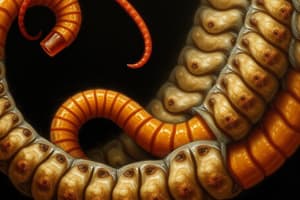Podcast
Questions and Answers
How are diseases caused by filarial nematodes primarily spread?
How are diseases caused by filarial nematodes primarily spread?
What is the role of mosquitoes in the life cycle of filarial nematodes?
What is the role of mosquitoes in the life cycle of filarial nematodes?
What is a common symptom associated with filarial nematode infestations in humans?
What is a common symptom associated with filarial nematode infestations in humans?
How are filarial nematode infestations typically diagnosed in patients?
How are filarial nematode infestations typically diagnosed in patients?
Signup and view all the answers
What is a common method used in the treatment of filarial nematode infestations?
What is a common method used in the treatment of filarial nematode infestations?
Signup and view all the answers
What plays a crucial role in transmitting most filarial nematode infections?
What plays a crucial role in transmitting most filarial nematode infections?
Signup and view all the answers
What is a common sign of filarial nematode infections?
What is a common sign of filarial nematode infections?
Signup and view all the answers
How can filarial nematode infections be diagnosed?
How can filarial nematode infections be diagnosed?
Signup and view all the answers
What is a key requirement for effective treatment of filarial nematode infections?
What is a key requirement for effective treatment of filarial nematode infections?
Signup and view all the answers
Which method can help confirm the presence of specific antigens associated with filarial infections?
Which method can help confirm the presence of specific antigens associated with filarial infections?
Signup and view all the answers
What is the primary target of antihelminthic drugs used in treating filarial nematode infections?
What is the primary target of antihelminthic drugs used in treating filarial nematode infections?
Signup and view all the answers
Study Notes
Filarial Nematodes
Filarial nematodes, also known as parasitic worms, are a group of roundworms that pose significant health risks to humans and animals worldwide. These elongated, threadlike worms can cause various diseases depending on their species, some of which have been around since ancient times. Despite being less common in developed countries, these parasites remain a major problem in tropical regions with poor sanitation and limited medical resources. In this article, we will explore the life cycles, disease transmissions, symptoms, diagnoses, and treatments associated with filarial nematode infestations.
Life Cycle
The life cycle of filarial nematodes typically involves two hosts: one definitive host where the adult worm lives and reproduces, and another intermediate host where the larvae develop before infecting the human body. For example, mosquitoes serve as vectors for several types of filarial worms, acquiring microfilaria from infected humans during blood feeding and subsequently passing them back into other people when they bite again.
Disease Transmission
Diseases caused by filarial nematodes are spread through the bites of infected arthropods called vectors. Some common vector organisms include blackflies, sand flies, deerflies, tsetse flies, horseflies, and mosquitoes. When the vector takes a blood meal from an infected human, it becomes a reservoir of infection capable of spreading the disease to others. Mosquitoes, especially members of the Anopheles genus, play a crucial role in transmitting most filarial nematode infections.
Symptoms
Symptoms vary between different types of filarial nematode infections and may take years to appear after initial exposure. Common signs include swelling, pain, tenderness, fever, fatigue, weakness, and enlarged organs such as the testicles, scrotum, labia, breast, ovaries, vulva, and glands near the eyes. Localized edema is often a prominent feature of many filariasis syndromes.
Diagnosis
Diagnosing filarial nematode infections requires laboratory tests due to the non-specific nature of clinical manifestations. Direct examination under a microscope might reveal eggs, adult worms, or microfilariae circulating in the bloodstream or tissue samples. Antigen detection methods using rapid diagnostic tests (RDT) or polymerase chain reaction (PCR) assays can help confirm the presence of specific antigens associated with filarial infections. Blood smears and skin snips are additional diagnostic tools used to detect microfilariae.
Treatment
Treatments for filarial nematode infections primarily involve administering antihelminthic drugs, which target the developmental stages of the parasite within its host. A single dose of ivermectin, albendazole, or diethylcarbamazine is often sufficient to eliminate microfilariae from the patient's system. However, treatment cannot reverse any damage already done to the body by the worms, so early diagnosis and intervention are essential.
In conclusion, filarial nematodes present complex challenges in global public health due to their potential for widespread transmission and prolonged effects on the human body. Understanding the life cycles, disease transmissions, symptom progressions, diagnostic techniques, and effective treatment options is critical for controlling these debilitating infections.
Studying That Suits You
Use AI to generate personalized quizzes and flashcards to suit your learning preferences.
Description
Explore the life cycles, disease transmissions, symptoms, diagnoses, and treatments associated with filarial nematode infestations. Learn about the complexities of these parasitic worms which pose significant health risks to humans worldwide.




